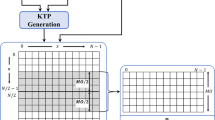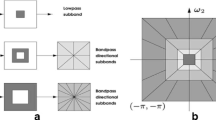Abstract
This paper proposes a novel shot boundary detection method which combines the Advantages of Particle Swarm Optimization (PSO) and Gravitational Search Algorithm (GSA) to optimize the weights of the Feed-Forward Neural Network (FNN). To increase the performance of the system, the output of the hybrid technique is again analyzed by forming a Continuity matrix (ϕ). Then an Outlier along with a Continuity matrix is used for extracting a possible set of transition frames. A set of thresholds δ1 and δ2 is selected for classifying abrupt and gradual transitions from the available set of possible transition frames. Experimental results using TRECVid 2001 depicts that PSOGSA outperforms GSA and PSO in-terms of training the feed forward neural network and generating a higher overall F1 score. The proposed system also gives better performance when compared with other latest techniques in-terms of F1 score.






Similar content being viewed by others
References
Koprinska I, Carrato S (2001) Temporal video segmentation: a survey. Signal Process: Image Commun 16 (5):477–500
Thounaojam DM, Trivedi A, Manglem Singh K, Roy S (2014) A Survey on Video Segmentation. Springer India, New Delhi, pp 903–912
Smeaton AF, Over P, Doherty AR (2010) Video shot boundary detection: Seven years of {TRECVid} activity. Comput Vis Image Underst 114(4):411–418. Special issue on Image and Video Retrieval Evaluation
Nagasaka A, Tanaka Y (1992) Automatic video indexing and full-video search for object appearances. In: Proceedings of the IFIP TC2/WG 2.6 Second Working Conference on Visual Database Systems II, (Amsterdam, The Netherlands, The Netherlands). Publishing Co., North-Holland, pp 113–127
Arman F, Depommier R, Hsu A, Chiu MY (1994) Content-based browsing of video sequences. In: ACM Multimedia, pp 97– 103
Arman F, Hsu A, Chiu M-Y (1993) Image processing on compressed data for large video databases, in International Conference on Multimedia, MULTIMEDIA ’93. ACM, New York, pp 267–272
Nakajima Y (1994) A video browsing using fast scene cut detection for an efficient networked video database access (special issue on networked reality). IEICE Trans Inf Syst 77:1355– 1364
Zhang H, Low CY, Smoliar SW (1995) Video parsing and browsing using compressed data. Multimed Tools Appl 1:89– 111
Pei S-C, Chou Y-Z (1999) Efficient mpeg compressed video analysis using macroblock type information. IEEE Trans Multimed 1(4):321–331
Zhang H, Kankanhalli A, Smoliar SW (1993) Automatic partitioning of full-motion video. Multimed Syst 1(1):10–28
Anjulan A, Canagarajah N (2007) Object based video retrieval with local region tracking. Signal Process: Image Commun 22(7):607–621
Junaid B, NITIN AS (2013) SHIN’ICHI, A framework for video segmentation using global and local features, vol 27
Gao Y, Yong J-H, Cheng FF (2011) Video shot boundary detection using frame-skipping technique. http://citeseerx.ist.psu.edu/viewdoc/summary?doi=10.1.1.134.8658
Lu ZM, Shi Y (2013) Fast video shot boundary detection based on svd and pattern matching. IEEE Trans Image Process 22:5136–5145
Liu F, Wan Y (2015) Improving the video shot boundary detection using the hsv color space and image subsampling. In: Seventh International Conference on Advanced Computational Intelligence (ICACI), pp 351–354
Boccignone G, Chianese A, Moscato V, Picariello A (2005) Foveated shot detection for video segmentation. IEEE Trans Circ Syst Video Technol 15:365–377
Cai C, Lam K, Tan Z (2005) Trecvid2005 experiments in the hong kong polytechnic university: shot boundary detection based on a multi-step comparison scheme. In: TRECVID 2005 Workshop Notebook Papers, National Institute of Standards and Technology, MD, USA
Fang H, Jiang J, Feng Y (2006) A fuzzy logic approach for detection of video shot boundaries. Pattern Recogn 39(11):2092–2100
Thounaojam DM, Khelchandra T, Singh KM, Roy S (2016) A genetic algorithm and fuzzy logic approach for video shot boundary detection. Comput Intell Neurosc 2016:2016
Sun X, Zhao L, Zhang M (2011) A novel shot boundary detection method based on genetic algorithm-support vector machine. In: 2011 Third International Conference on Intelligent Human-Machine Systems and Cybernetics, vol 1, pp 144–147
Gaurav S, Wencheng W, Dalal EN (2005) The ciede2000 color-difference formula Implementation notes, supplementary test data, and mathematical observations. Color Res Appl 30(1):21–30
Xu J, Song L, Xie R (2016) Shot boundary detection using convolutional neural networks. In: Visual Communications and Image Processing (VCIP), pp 1–4
Bo Gao X, Han B, Bing Ji H A shot boundary detection method for news video based on rough sets and fuzzy clustering. In: Proceedings of the Second International Conference on Image Analysis and Recognition, ICIAR’05. Springer, Berlin, pp 231–238
Thounaojam DM, Bhadouria VS, Roy S, Singh KM (2017) Shot boundary detection using perceptual and semantic information. Int J Multimed Inf Retr 6:167–174
Rashedi E, Nezamabadi-pour H, Saryazdi S (2009) Gsa: a gravitational search algorithm. Inf Sci 179:2232–2248
Jadon R, Chaudhury S, Biswas K (2001) A fuzzy theoretic approach for video segmentation using syntactic features. Pattern Recogn Lett 22(13):1359–1369
Kennedy J, Eberhart R (1995) Particle swarm optimization. In: 1995 IEEE International Conference on Proceedings Neural Networks, vol 4, pp 1942–1948
Mirjalili S, Hashim SZM, Sardroudi HM (2012) Training feedforward neural networks using hybrid particle swarm optimization and gravitational search algorithm. Appl Math Comput 218(22):11125–11137
Zhang H, Hu R, Song L (2011) A shot boundary detection method based on color feature. In: Proceedings of 2011 International Conference on Computer Science and Network Technology, vol 4, pp 2541–2544
Kar T, Kanungo P (2017) A motion and illumination resilient framework for automatic shot boundary detection. Signal Image Video Process 11:1237–1244
Tippaya S, Sitjongsataporn S, Tan T, Khan MM, Chamnongthai K (2017) Multi-modal visual features-based video shot boundary detection. IEEE Access 5:12563–12575
Lakshmi Priya GG, Domnic S (2014) Walsh-hadamard transform kernel-based feature vector for shot boundary detection. IEEE Trans Image Process 23:5187–5197
Author information
Authors and Affiliations
Corresponding author
Additional information
Publisher’s note
Springer Nature remains neutral with regard to jurisdictional claims in published maps and institutional affiliations.
Rights and permissions
About this article
Cite this article
Chakraborty, S., Thounaojam, D.M. A novel shot boundary detection system using hybrid optimization technique. Appl Intell 49, 3207–3220 (2019). https://doi.org/10.1007/s10489-019-01444-1
Published:
Issue Date:
DOI: https://doi.org/10.1007/s10489-019-01444-1




